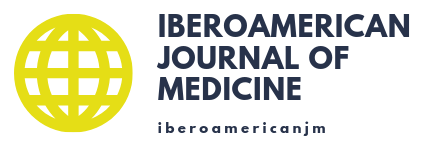Treatment outcomes and influencing factors on patients with Pulmonary Tuberculosis: a retrospective study
Jamshid Ayatollahi, Abolhasan Halvani, Mohammadhesam Gharaei Khezri, Seyed Hossein Shahcheraghi
Abstract
Introduction: Tuberculosis infection caused by Mycobacterium tuberculosis is one of the most common infectious diseases, especially in countries such as Iran. The course of treatment and the number of drugs used vary depending on the severity of the disease and the parts of the body involved. The resistant tuberculosis to treatment has increased in recent years. Thus, this study was conducted to investigate the frequency distribution of response to treatment of patients with tuberculosis in Sirjan, Iran.
Methods: This descriptive cross-sectional study investigated all patients with tuberculosis in Sirjan city who had referred to health centers during the years 2011-2019. The data collection tool was a pre-prepared checklist that included information on age, sex, sputum smear results, sputum culture results, diabetes, patients' nationality, drug side effects, and response to treatment. Finally, data was entered into SPSS version 22, and analyzed.
Results: In this study, the overall response rate was 83% and the mortality rate was 10%. Between the frequency distribution of response to treatment in terms of gender, age, sputum smear results, sputum culture results, patients' nationality and diabetes was not statistically significant difference. Also, no statistically significant difference was found between the frequency distribution of pulmonary TB treatment response in terms of drug allergy, drug hepatitis and other drug side effects.
Conclusion: According to results, can be concluded that none of the variables: age, sex, smear and culture result, and history of diabetes have no an effect on response to treatment and mortality of tuberculosis.
Keywords
References
1. Mok J, An D, Kim S, Lee M, Kim C, Son H. Treatment outcomes and factors affecting treatment outcomes of new patients with tuberculosis in Busan, South Korea: a retrospective study of a citywide registry, 2014-2015. BMC Infect Dis. 2018;18(1):655. doi: 10.1186/s12879-018-3574-y.
2. Atif M, Anwar Z, Fatima RK, Malik I, Asghar S, Scahill S. Analysis of tuberculosis treatment outcomes among pulmonary tuberculosis patients in Bahawalpur, Pakistan. BMC Res Notes. 2018;11(1):370. doi: 10.1186/s13104-018-3473-8.
3. Tola A, Mishore KM, Ayele Y, Mekuria AN, Legese N. Treatment Outcome of Tuberculosis and Associated Factors among TB-HIV Co-Infected Patients at Public Hospitals of Harar Town, Eastern Ethiopia. A five-year retrospective study. BMC Public Health. 2019;19(1):1658. doi: 10.1186/s12889-019-7980-x.
4. Mohammed T, Daniel K, Helamo D, Leta T. Treatment outcomes of tuberculosis patients in nigist Eleni Mohammed general hospital, hosanna, southern nations, nationalities and peoples region, Ethiopia: a five year (June 2009 to August 2014) retrospective study. Arch Public Health. 2017;75:16. doi: 10.1186/s13690-017-0184-x.
5. Gao J, Ma Y, Du J, Zhu G, Tan S, Fu Y, et al. Later emergence of acquired drug resistance and its effect on treatment outcome in patients treated with
Standard Short-Course Chemotherapy for tuberculosis. BMC Pulm Med. 2016;16:26. doi: 10.1186/s12890-016-0187-3.
6. Wen Y, Zhang Z, Li X, Xia D, Ma J, Dong Y, et al. Treatment outcomes and factors affecting unsuccessful outcome among new pulmonary smear positive and negative tuberculosis patients in Anqing, China: a retrospective study. BMC Infect Dis. 2018;18(1):104. doi: 10.1186/s12879-018-3019-7.
7. Gebrezgabiher G, Romha G, Ejeta E, Asebe G, Zemene E, Ameni G. Treatment Outcome of Tuberculosis Patients under Directly Observed Treatment Short Course and Factors Affecting Outcome in Southern Ethiopia: A Five-Year Retrospective Study. PLoS One. 2016;11(2):e0150560. doi: 10.1371/journal.pone.0150560.
8. Ahmad T; Haroon, Khan M, Khan MM, Ejeta E, Karami M, Ohia C. Treatment outcome of tuberculosis patients under directly observed treatment short course and its determinants in Shangla, Khyber-Pakhtunkhwa, Pakistan: A retrospective study. Int J Mycobacteriol. 2017;6(4):360-4. doi: 10.4103/ijmy.ijmy_69_17.
9. Ejeta E, Beyene G, Balay G, Bonsa Z, Abebe G. Factors associated with unsuccessful treatment outcome in tuberculosis patients among refugees and their surrounding communities in Gambella Regional State, Ethiopia. PLoS One. 2018;13(10):e0205468. doi: 10.1371/journal.pone.0205468.
10. Dale D, Nega D, Yimam B, Ali E. Predictors of poor tuberculosis treatment outcome at Arba Minch General Hospital, Southern Ethiopia: a case-control study. J Tuberc Ther. 2017,2(1):110.
11. Peltzer K, Louw JS. Prevalence and factors associated with tuberculosis treatment outcome among hazardous or harmful alcohol users in public primary health care in South Africa. Afr Health Sci. 2014;14(1):157-66. doi: 10.4314/ahs.v14i1.24.
12. Getie A, Alemnew B. Tuberculosis Treatment Outcomes and Associated Factors Among Patients Treated at Woldia General Hospital in Northeast Ethiopia: An Institution-Based Cross-Sectional Study. Infect Drug Resist. 2020;13:3423-9. doi: 10.2147/IDR.S275568.
13. Khazaei S, Hassanzadeh J, Rezaeian S, Ghaderi E, Khazaei S, Hafshejani AM, et al. Treatment outcome of new smear positive pulmonary tuberculosis patients in Hamadan, Iran: A registry-based cross-sectional study. Egypt J Chest Dis Tuberc. 2016;65(4):825-30. doi: 10.1016/j.ejcdt.2016.05.007.
14. Korhonen V, Lyytikäinen O, Ollgren J, Soini H, Vasankari T, Ruutu P. Risk factors affecting treatment outcomes for pulmonary tuberculosis in Finland 2007-2014: a national cohort study. BMC Public Health. 2020;20(1):1250. doi: 10.1186/s12889-020-09360-7.
15. Fentie AM, Jorgi T, Assefa T. Tuberculosis treatment outcome among patients treated in public primary healthcare facility, Addis Ababa, Ethiopia: a retrospective study. Arch Public Health. 2020;78:12. doi: 10.1186/s13690-020-0393-6.
Submitted date:
01/06/2021
Reviewed date:
01/30/2021
Accepted date:
02/05/2021
Publication date:
02/07/2021

